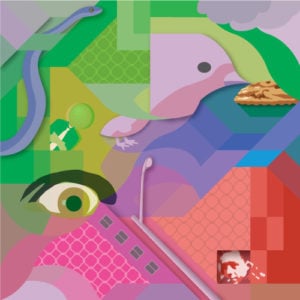
This week, the Reads beat staff is interested in absurdist fiction, stories that reflect the inane ridiculousness of life. Entering the temporary purgatory of finals week, these selections will remind you that life outside of Palo Alto is just as crazy and weird as any day on the Farm.
Samuel Beckett, “Quad” — Shana Hadi, staff writer
When you combine geometric quadrangles with a television play, your results may vary. Samuel Beckett, perhaps most famous for “Waiting for Godot,” increasingly favored minimalist approaches to theater as he aged, and “Quad” in particular has continued to puzzle me for its sheer bizarreness. On a surface level, I can admire its commitment to precision through the interplay of the actors’ footsteps thudding across the stage in unison with each other and the steady percussion beats. Aesthetically, I can appreciate the solemnity of the stark lighting jarring with the actors dressed in primary colors and white, and how the actors’ movements methodically follow the sharp outline of the square. Conceptually? Suffice to say, I’m lost. Short of declaring “there’s no meaning” (which is a perfectly acceptable response), all I can grasp are the motifs of repetition and cyclical movement, and the return to primordial, simple imagery. But perhaps that’s the point. Instead of delving into multilayered themes or lists of characters, Beckett actively chooses the relative beauty of rational shapes and movements organized through time. As an audience member, who wouldn’t appreciate just resting in the mundanity of hooded figures jaunting across the stage with the echoing beat of a drum? I’ll end here and let you decide; saying more would rail against the experimental spirit of the play.
Tom Stoppard, “Rosencrantz and Guildenstern Are Dead” — Claire Francis, desk editor
Tom Stoppard’s stage play is a darkly amusing, dreamlike riff on Shakespeare’s “Hamlet” that literalizes the inescapability of the script — that is to say, the world — and the role one occupies in it. Starring the two most ill-defined individuals of a text so needlessly labyrinthine that pirate abduction is an afterthought, “Rosencrantz and Guildenstern Are Dead” magnifies Hamlet’s existentialist problem into a universal examination of meaning in the face of human helplessness. The “Hamlet”-specific humor, such as the constant confusion of Rosencrantz with Guildenstern (and vice versa), is a charming wink to an informed audience, but it more importantly augments the themes with which the text already toys. Guildenstern’s and Rosencrantz’s foreknowledge of their fate is an unfortunate truth they must reconcile with their desires for self-determination and individuality; wordplay, constructivism and casual suicidality thus make up the play’s almost dadaist comedy. Read this if you want to contemplate your cosmic insignificance instead of sleeping.
Thomas Pynchon, “Inherent Vice” — Ashley Huang, contributing writer
Thomas Pynchon’s screwball detective novel takes his usual fodder — unsolvable conspiracies, meandering plots, paranoid protagonists — and elevates it to new heights. Literally — it’s the tail end of the ’60s in California, and everyone in this book is high. We follow Larry “Doc” Sportello, a flip-flop wearing hippie-turned-private-eye, as he wanders the beach fronts investigating the scheme to end all schemes and trying to do a little good along the way. Like waves, plot points rise, crest and slide back into one another: there’s something about a kidnapped land developer, an institute called the Golden Fang and an LAPD-funded assassination ring. Surprisingly, Doc tackles these bizarre turns with an admirably simple go-with-the-flow attitude, and the book’s end has a sweetness to it that makes me hesitate to call it absurdist literature. Yet Pynchon makes it clear that the ability to remain unperturbed in the face of hellish bureaucratic nonsense is slowly slipping away with the rest of the decade. Repression and institutions are choking all the free love out of California. Blaze it while you still can, kids.
Kurt Vonnegut, “Cat’s Cradle” — Isabella Ainsworth, contributing writer
Although he never completed his degree, Vonnegut’s time spent studying chemical engineering at Cornell is put to good use in “Cat’s Cradle.” Science fiction, irreverent humor, quack religions and universal themes combine to create an entertaining read in this novel about an everyday schmo named John who finds himself at the start of an apocalypse brought on by Ice-nine. The situation, while seemingly absurd, is made more realistic by the fact that at the outset of the novel John is researching what people were doing when the nuclear bomb on Hiroshima is dropped. If a whole city can be annihilated in a matter of seconds by a single bomb, then is it really absurd to imagine that an apocalypse could come in a different form of ice? The best part of the book, perhaps, is that the end of world scenario coupled with “Bokonism” also allows Vonnegut to dispense his wit with extremely quotable lines like “There is love enough in this world for everybody, if people will just look.” Although books should not just be read so that later for their ability to make really good posters, if making good posters or coasters or any other type of merchandise were a criteria for you, Vonnegut’s “Cat’s Cradle” would pass the test.
Contact Shana Hadi at shadi ‘at’ stanford.edu, Claire Francis at claire97 ‘at’ stanford.edu, Ashley Huang at ashhuang ‘at’ stanford.edu and Isabella Ainsworth at ijains ‘at’ stanford.edu.
